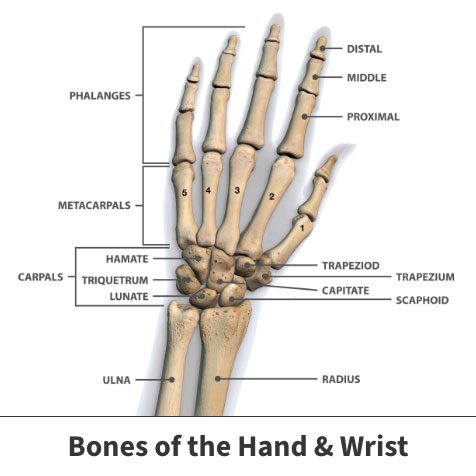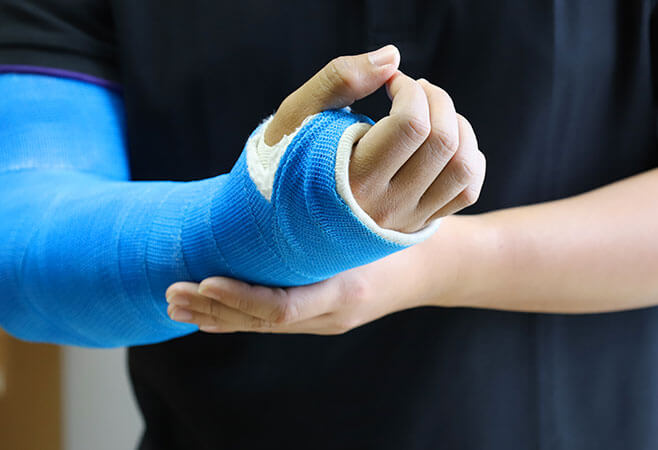Broken wrist
Wrist fractures
A wrist fracture is the medical term used for a broken wrist. The wrist is made up of eight bones that connect with the forearm bones, known as the radius and the ulna. A fractured wrist can result when any of these bones are injured. The most common type of wrist fracture is the result of a break in the radius bone, known as a Colles’ fracture or radius fracture.
Anatomy

The eight small bones of the wrist are connected by ligaments, nerves and tendons, which allow for rotation, flexibility and movement in different directions. These bones, also known as carpal bones, are placed in two rows:
The first row, known as the proximal row and located closest to the forearm, is composed of the:
- Scaphoid
- Lunate
- Triquetrum
- Pisiform
The second row, known as the distal row and located closest to the fingers, is composed of the:
- Trapezium
- Trapezoid
- Capitate
- Hamate
About
A wrist fracture can occur for many reasons. Most commonly, it is the result of an injury when falling onto a hand that is outstretched. Other causes include severe trauma to the wrist and forearm from a motor or vehicle accident, direct trauma from high-risk contact sports, and can even be the result of frail and weakened bones due to conditions such as osteoporosis.
Symptoms
A wrist fracture can result in great pain, and the symptoms can depend on the severity of the injury. General symptoms may include:
- Tenderness
- Swelling
- Bruising
- Paleness in the fingers or wrist
- Tingling or numbness throughout the fingers, wrist, and arm
- Deformity of the fingers and wrist, causing it to look bent or crooked
- Stiffness and inability to move wrist or fingers
Diagnosis
Your Florida Orthopaedic Institute physician will evaluate your symptoms and determine the cause of your pain. A fractured wrist can sometimes be determined through a physical exam. A series of X-rays may be performed since a fracture to the small bones may often be challenging to detect at first glance.
Treatment
Your physician will discuss all options for your treatment to determine which is the best for your needs. Treatment required to heal a fractured wrist will depend on the severity of the injury. In the beginning stages of the injury, over the counter painkillers such as (NSAIDs) like ibuprofen and aspirin can be used as an anti-inflammatory but if severe pain persists, your physician can determine if a stronger painkiller will be prescribed and if a cast or surgery is required.
Nonsurgical treatments
Florida Orthopaedic Institute physicians provide patients with all nonsurgical options before surgery is recommended. If the pain is not as severe, nonsurgical treatment methods can be used to reduce the pain of the fractured wrist. Generally, if a splint is required, it will be used in the initial stages while swelling subsides, and then a cast will be put on. Elevating your wrist with a pillow may ease any swelling and pain. A cast may need to remain on from six to eight weeks, or longer based on the injury. Regular checkups with X-ray will be essential to check the progress and determine if the cast is loosening. If the cast becomes too loose after additional swelling goes down, a new cast will be required to ensure that proper healing takes place.
Casts and splints are common nonsurgical treatments for wrist fractures. Generally, a splint is used in the initial stages while swelling subsides, followed by a cast.
Surgical treatments
Often, nonsurgical treatments will be enough to fix a fractured wrist, but it is not uncommon to need surgery if a wrist is broken. Your physician may suggest surgery if the bone is not likely to heal correctly with a splint and cast. During wrist surgery, small pins, screws, plates or other devices are used to keep the bone in place to heal and mend.

Videos
Related specialties
- Basal Joint Surgery
- Carpal Tunnel Syndrome
- De Quervain's Tenosynovitis
- Dislocated Finger
- Distal Radius Fracture (Broken Wrist)
- Dupuytren’s Disease
- Flexor Tendonitis
- Fractured Fingers
- Functional Nerve Transfers of the Hand
- Ganglion Cysts
- Hand & Finger Replantation
- Hand Nerve Decompression
- Hand Skin Grafts
- Nerve Pain
- Peripheral Nerve Surgery (Hand) Revision
- Revascularization of the Hand
- Rheumatoid Arthritis of the Hand
- Sports Wrist & Hand Injuries
- Sprained Wrist
- Sudden Acute Finger, Hand & Wrist Injuries
- Targeted Muscle Reinnervation (TMR)
- Tendon Transfers of the Hand
- Thumb Ulnar Collateral Ligament Injuries
- Trigger Finger
- Ulnar Neuritis
- WALANT (Wide Awake Local Anesthesia No Tourniquet)
- Wrist Arthroscopy
- Wrist Tendonitis
